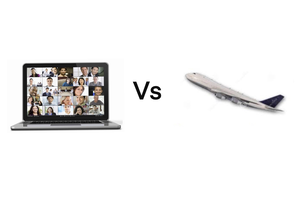Hotels and airlines are still struggling through the downturn in travel due to COVID. The ripples throughout industries and businesses that require travel are limiting their employees in order to minimise the risk of spreading the disease but also the liability, because for every company that is traveling there are 10 that aren’t, so you better be able to justify this risk. Air travel is down to approximately 20% according to TSA.
Hotels are far below capacity and have cut back on staff. Many hotels will not clean the rooms until checkout or on-demand if the guest is not in the room. Some hotels were even rationing toilet paper when this first started due to the shortage says Joseph Zulick of MRO Electric and Supply.
Everyone is taking precautions including wearing masks, disinfecting room keys, and even cleaning and wrapping the remote in plastic. Rooms have stickers on them after cleaning to indicate no one has been in after the staff has left. But why are we not going back on the road?
Part of this has to do with our new-found acceptance of technology. Let’s walk through an average day. No longer are you getting up, rushing through your breakfast; racing out only to sit in traffic for 45 minutes after you brush the snow off your car in winter, or let it cool off in the summer. Working remotely is the current trend.
You get up and reach to the nightstand for your tablet or phone and check emails, log into your sharing software such as MS Teams and get updates on your projects from your other co-workers. You may log in on your laptop to your company’s portal and access your work folders and spreadsheets. You surf over to the web publisher site to view the status of your equipment using machine reporting software such as Linknet. You gather the production numbers and jump in the shower.
When you get out, you’re not sprinting to the airport to make it to a meeting at headquarters in Ohio. No, you won’t be getting to the airport an hour early to clear security and check in luggage, travel via 2 hour-long flights, and a 45-minute layover, providing you make your connection and that hurricane doesn’t cause delays in your connection city. Instead, you walk into the living room and log in to Zoom for an international production meeting where you can share screen views of the production in the plant.
Downtimes are reported from the industrial internet of Things (IIoT) sensors for heat from a bearing probe. It shows the current status as offline and the SAP software shows that production was diverted to a secondary line and that production demands would be met despite the problem. Maintenance is showing the sensor is now back online after the bearing replacement. The estimated completion of the part run is 1:03 pm.
Your counterpart from the plant in New Mexico, shares their screen showing a similar problem they had and the damage marks on the bearing. The root cause turned out to be a lube pump which was not pumping to the bearing due to a recall on the pump distribution block. You email a message to maintenance advising them of this concern so they can perform this repair before turning the machine over to production.
OEE trending reports show an improvement in all areas except the manual fed equipment, a suggestion from the VP in Toronto provides a solution they had found by adding automatic clamping yielded a 5% production time improvement. The uptime improvement would pay for the $5,000 (€4,226.63) investment in 6 months.
The meeting ends and you prepare for the engineering process change meeting at 10am to discuss how in-die tapping could save a secondary operation. You review drawings and materials information downloaded from the vendor site and create a new workflow in Teams. Another vendor uses Trello and you can share their documents in the customer access portal that provides you with material capacities for switching to stainless steel.
An email comes in from the sales team indicating forecasts from the sales force software. It shows an uptick in the demand from the current material which would slow-changing over to the new material. A quick Webex meeting with your boss produces some important specifications that would indicate that the changeover may require outside production for 2 months to service the old products while the new line is changed over to stainless steel.
The engineering meeting pulls in the new engineers from Germany at the Berlin plant and they offer their ability to produce the parts during this 2-month time frame. You open your logistics software to review what new robotics and augmented reality software could do to improve your warehouse flow and streamline your reporting which can now integrate into your main software for resource planning.
This saves time and provides a faster way to locate, track, and report inventory management. The virtual reality test that provided feedback on the new part carriers was not a success since it showed that it would cause ergonomic issues in the part handling and the carriers would need to be lowered 5 inches. At least this gave you this information before you spent $250,000 (€211,331.25) on the carriers, now they can be corrected prior to manufacturing the system.
Lunchtime, but, with COVID the better choice is voice ordering via Google home and a door dash delivery of your favorite dish. Since you’re not heading out to lunch you can get in that treadmill walk as you get the podcast update on the new technology from the tech show that’s gone virtual instead of occurring in Detroit.
After lunch, you have a budget Skype call with Paris to discuss new features in the concur software that maps to the SAP software saving time for all the expense reports and providing budgetary data and trending analysis.
Artificial intelligence is providing trending forecasts that failures are imminent! The IIoT data gathered from the machines indicate that vibration analysis shows that 10% of the machines are running at cutting speeds too fast for the material causing excess vibration and wear. A program change is made automatically and a material analysis report request is initiated.
The material analysis indicates that the steel that was used is harder than it was in the past and in order to prevent this from happening in the future a sensor is installed to measure the hardness of the material as it enters the machine. The hardness is mapped to a table and now the hardness dictates the spindle speed automatically.
Meanwhile, as you get ready to head home for the day you can rest assured that Artificial Intelligence is still hard at work optimising the production schedule based on overnight numbers and reports from the machines giving their status reports. Maintenance is working on a bad motor control using google glass and communication software that’s allowing a technician in Buffalo to talk to your technician on the floor and allows them to see what he is seeing.
The end of the day wraps up with a transition meeting via Skype with the night managers to go over all the status reports and what fires still are in existence from early in the day.

These technologies are not limited to manufacturing. Think about when you get home… wait that’s right; You are home! When the air conditioning goes out those same augmented reality programs can be put on your tablet to walk an AC technician through what’s happening in your house. They can hear what you hear and they can see what you see. They can highlight on the screen where they want you to look and what they want you to try. Checking fuses and power to help diagnose the problem in a tenth of the time and a reduced cost.
How many sensors and inputs do we need or use? 90% of the world’s data has been created in the last couple years!.
Still think you need to catch that flight to Ohio? Is that trip into the office as productive as you thought? Maybe this is the time to re-evaluate what you thought was possible? You didn’t think you’d use that meeting software 6 months ago, now you’re using it daily. What else can yield benefits? Make that change!
The author is Joseph Zulick is a manager at MRO Electric and Supply.
Comment on this article below or via Twitter: @IoTNow_OR @jcIoTnow










